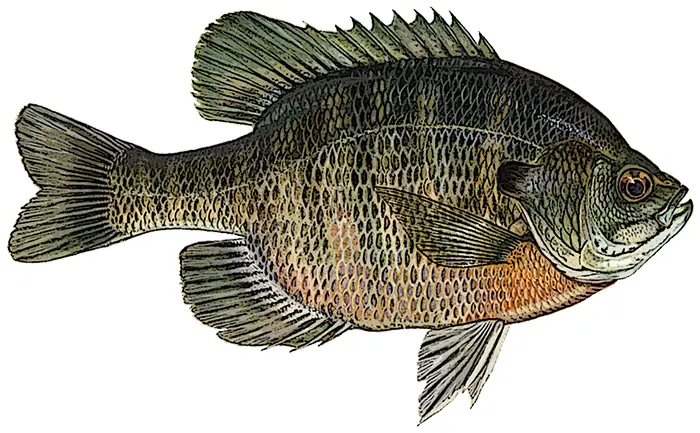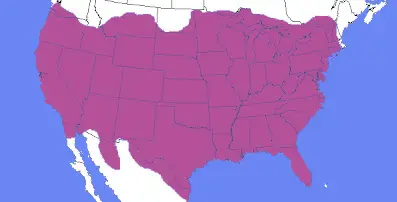Bluegill (sometimes called bream, brim or sunny) are one of the most popular panfish to catch in North America. They are abundant in freshwater lakes, rivers, streams, and ponds and have been introduced in most areas throughout North America.
If you’re fishing for bluegill, we created this guide for you. Here we will cover a little bit of basic info about bluegill, where to catch them, the equipment you need, and a few additional tips to help you catch more bluegill.
What Do Bluegill Look Like?

Bluegill are known for their black gill flap. They also have vertical bars on the sides of their bodies and a dark blotch near their dorsal fin.
On average most bluegill are around four to nine inches in length, with larger bluegill weighing 12 to 16 inches. The world record bluegill weighed roughly 4 pounds and 12 ounces.
Where to Catch Bluegill

Bluegill can be caught in freshwater lakes, rivers, ponds, and streams throughout North America. You can commonly fish them near docks, grassy shorelines, lily pads, and near structure in shallow waters such as trees. Seasonal factors can affect how likely bluegill are to be in one area or another
Seasonal Patterns
Fall
When the water begins to cool in the fall, bluegill move into the shallows. Look for them near docks, grassy shorelines, and structure in shallow waters. For fall fishing spinners, jigs, topwater lures, and flies are great options for catching bluegills in the shallows.
Though most bluegills move to the shallows In the fall, if you are fishing for larger bluegills, they are often found around 15 to 20 feet deep. You may want to use a fish finder to locate small schools in the waters you are fishing.
Winter
Bluegill still feed pretty actively during the colder months, so you can still fish them if you know where to look. When the water is cold, the bluegills move from the shallows into deeper waters. Look for them near creek channels and bluff edges. The most likely spots have cover where the bluegill can hide from predators. Fallen trees in deeper waters are always a likely spot.
When you find an area with bluegill, they are often tightly packed in schools in the winter. So once you locate one, there should be plenty to fish from. Just remember that they are lethargic in the winter, so use slower retrieves. If your presentation moves too fast the lethargic fish may not chase it.
Spring
Bluegill can be very aggressive in the springtime which makes it great for fishing. If you’re fishing the north, in early spring many bluegill may still be offshore in their winter hangouts. When the water warms up they will move into the shallows. This happens sooner in the south. Look for them on the outer edges of grass beds and in sandy flats near cover, near docks, or fallen trees.
Summer
If you’re fishing for big bluegills in the summertime, look for healthy green weed areas. Coontail and milfoil can be great signs because bluegill tend to use these as cover to hide from predators. Search for weed beds around 5 to 12 feet. You can find bluegill in just about most areas of water, but bigger bluegills tend to stay a little deeper.
Bluegill also spawn in the summertime, so you can find the beds they use for spawning to catch them. They typically dig out depressions in the sand to lay their eggs. Look for weedy protected bays with gravel or sandy bottoms. If you’re searching for the spawning areas, look for their “elephant tracks” which are round craters that mark their spawning nests. Using small live bait can work really well for fishing the spawning areas.
Fishing Equipment
Rods and Reels
For most areas you will fish for bluegill a spinning rod and reel will work extremely well. Use an ultralight rod around 4 to 5 feet in length with a fast action. A faster action will give you more sensitivity for catching small panfish like bluegill. This will allow you to set your hook much faster.
Many anglers also love to fish for bluegill with cane poles or fly rods. If you want to use a cane pole try something around 12 to foot in length with fast action. If you’re wanting to use a fly rod we recommend a lighter 4 to 5 weight rod with fast action. Again the key here is that you want a good amount of sensitivity for these smaller fish to be able to quickly set your hook when needed. Learn more about catching bluegill with fly gear.
Lures and Baits
Bluegill isn’t the pickiest feeders. The key is to make sure you using something small enough for their mouths. Check out our full list of the best bait for bluegill.
Spinners
Spinnerbaits work very well when the fish are more actively feeding. Fish near weed beds and other areas where the bluegill are searching for food. Usually, a steady retrieve will work best but you can also try casting it and letting it sink near the bottom, and then retrieve it.
Rooster Tail
When the water is cloudy using a good rooster tail lure is always a great option for catching bluegill. Use a small model with a slow and steady retrieve. The blade should just barely be spinning if you are using it correctly.
Spoons
In lakes and rivers wobbling spoons can really get the bluegill biting. You can also use jigging spoons productively in deep areas if you are fishing in the winter or summer seasons. Just remember in winter when fish are lethargic you will need to jig it very slowly to get a bluegill interested.
Topwater Poppers
Nothing is more exciting than getting a little topwater action. When hungry bluegill are in the shallows you can effectively use topwater poppers to attract bites. Toss them over grassy shorelines or weed beds when the bluegill are near the surface.
Worms
The classic worm also tends to work great for bluegill. Nightcrawlers and mealworms tend to work best. Just don’t use too large of a worm. If you’re using a nightcrawler it may be best to just use a piece big enough to cover the hook.
Grubs
Grubs can be the best bait for getting panfish like bluegill to bite. You can use them in most seasons to tip your jig heads and find them productive. They also tend to work well in winter months when the fish are a little slower and won’t give chase. If you plop a grub right next to them, even the most lethargic fish might try a bite.
Crickets and Grasshoppers
Bluegill are also known to eat crickets and grasshoppers, so they can work very well too. Usually live ones work best. Try to set them about 1 to 3 feet below a small bobber and cast them into the water.
Dough Balls
Dough balls can be extremely effective for getting bluegill to bite. There is something satisfying about using your own homemade creation. It’s also a fun project to make and use when fishing with kids. Learn how to make dough balls for bluegill
Fishing Line
The best fishing line for catching bluegill is a very light line. Monofilament line is the most popular for catching smaller panfish like bluegill. A 2 to 4-pound test monofilament line should work fine for most situations.
You may also prefer a fluorocarbon line or braided line.
Fluorocarbon line is popular because it is nearly invisible. Bluegill do have pretty good eyesight, so using fluorocarbon or a fluorocarbon leader can be a good option. Braided line is popular because you want good sensitivity for bluegill. Braided line is usually thinner and more sensitive than other lines.
Hooks
Bluegill tend to have small mouths so you don’t want to use too large of a hook. If your hook is too large the bluegill will steal your bait or you could have a poor hook set. The best hook size for bluegill is a size #6, #8 or #12 hook. Aberdeen hooks, bait holder hooks, jig hooks, or worm hooks work fine.
Bluegill Fishing Tips
Use Live Bait
Using live bait is often the best for catching hungry bluegill. Even in wintertime grubs and small fresh bait can entice the bluegill to bite. Nightcrawlers, mealworms, crickets, and grasshoppers are great for bluegill. You can also tip your lures and jig heads with small pieces of worms to make them more enticing.
Match the Hatch
No matter the fish you are catching, match the hatch is always relevant. Try to figure out what the bluegill are commonly eating in the waters you are fishing and use this as your bait. If you want to use an artificial lure, use one that mimics the forage of bluegill.
Think Small
It’s important to remember that bluegill have small mouths, so you can’t use too large of a hook or too large of a bait. Stick around a size #6 to #8 hook for your average bluegill. If you’re using worms, use a smaller chunk that will just cover the hook.
Keep a Low Profile
Bluegill can spook pretty easily, so try not to cast right on top of them. Cast your lure past the strike zone and gently retrieve your bait through their colony. They tend to scatter when something hits the surface of the water, which is why you don’t want to cast right on top of them.
Use the Proper Rig
A properly setup bluegill rig can work wonders for landing big bluegill. There are many different kinds of rigs you can use but some of the most effective are: drop shot rigs, bobber rigs, and split shot rigs. Learn how to set up these rigs for bluegill.
Commonly Asked Questions about Bluegill
What Do Bluegills Eat?
Bluegill are known to commonly eat other small fish, worms, insects, and zooplankton. They are not picky at all when it comes to feeding. They are known to eat almost anything thrown in the water.
How to Hold a Bluegill
Bluegills are known for having spiny dorsal fins which can be pretty sharp.
To hold bluegill, you have to pick them up towards the front of their head while laying their dorsal fins down to keep them from pointing.
Here’s a great video on handling fish which will give you a few pointers if you’re new to fishing.
What Does Blue Taste Like?
If you’re going to fry up some panfish, bluegill can definitely be a good option. They are known to be firm and flaky which makes the meat very tasty. They are one of the best tasting panfish according to many avid anglers.
